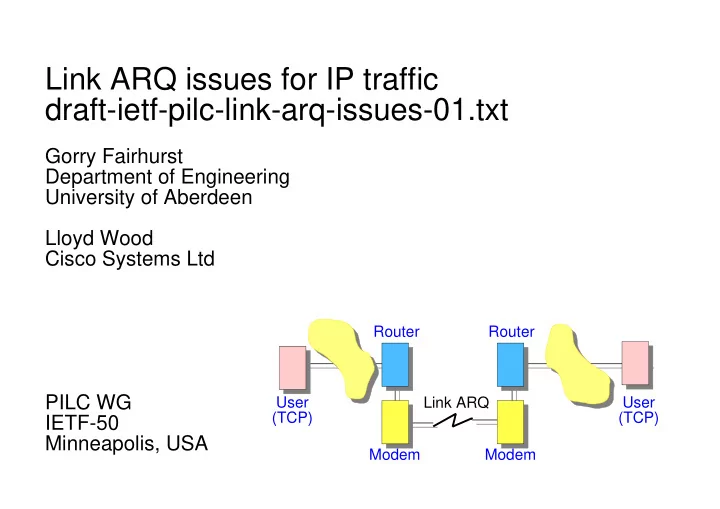

Link ARQ issues for IP traffic draft-ietf-pilc-link-arq-issues-01.txt Gorry Fairhurst Department of Engineering University of Aberdeen Lloyd Wood Cisco Systems Ltd Router Router PILC WG User Link ARQ User (TCP) (TCP) IETF-50 Minneapolis, USA Modem Modem
ARQ Persistence G. Fairhurst & L Wood, IETF-50, Minneapolis IP doesn’t require strict reliability IP flows benefit from: (i) low loss (ii) timely delivery Types of link ARQ: None 180 Low Persistence (e.g. 802.11) Comparison at frame error rate of 0.1 160 High Persistence (e.g. irDA) 140 120 Perfect Persistence (e.g. HDLC) 100 80 60 40 1 2 3 4 Average throughput for one TCP bulk flow (5 MB) 20 Link rate = 2 Mbps, 0 Frame size = 52 B, 0.6 0.9 1.2 1.8 64 Link RTT = 600 ms Frame error rate = 0.1 Time (Sec) Persistency needed depends upon anticipated error rate / duration
Edits applied to -01 G. Fairhurst & L Wood, IETF-50, Minneapolis Many small “fixes” to wording Incorporated feedback to list / authors Clarification of persistence in shared links Ethernet example changed Persistence impacts utilisation Eliminated 64 sec constraint Not clear how this applies to link layer
Key Issue 1: Sharing - Low Persistence G. Fairhurst & L Wood, IETF-50, Minneapolis Speed bumps Low persistence ARQ, 4 TCPs Link rate = 2 Mbps, Frame size = 52 B, Link RTT = 600 ms Frame error rate = 0.2 Time (Sec) Single link, multiple flows Bounded impact on path RTT Some loss Speed bumps
Key Issue 1: Sharing - High Persistence G. Fairhurst & L Wood, IETF-50, Minneapolis All flows suffer together High persistence ARQ, 4 TCPs Link rate = 2 Mbps, Frame size = 52 B, Link RTT = 600 ms Frame error rate = 0.2 Time (Sec) Single link, multiple flows Link ARQ jitter impacts all sessions Reduction in throughputs of other sharing flows Proposed solutions with high persistence Requires “fine grain” differentiation, per flow processing Research issue with large numbers of flows
Bumps & Bursts G. Fairhurst & L Wood, IETF-50, Minneapolis High Persistence ARQ (§2.2) cwnd remains open RTO grows with increased link jitter “Microscopic” TCP transmit bursts Low Persistence ARQ (§2.3) cwnd reduces after TCP retransmission Bounded impact on RTO ARQ delay “Macroscopic” speed bumps Loss reduces average throughput Burst High persistent ARQ, Single TCP Link rate = 2 Mbps, Frame size = 52 B, Time (Sec) Link RTT = 600 ms Frame error rate = 0.2 TCP with High Persistence ARQ
Key Issue 2: Classification G. Fairhurst & L Wood, IETF-50, Minneapolis Not all applications need high persistence ARQ Delay-sensitive flows suffer (e.g. RTP/UDP) Implicit differentiation is a hard problem (ARQ § 3.2) New applications require adding new interpreters Cost per packet needs considered (not fast-path decision) How does link map flow to ARQ behaviour? Flow type does not imply ARQ persistence (semantic gap) Without this, difficult to advocate hi-persistent approach
Key Issue 3: Multiple Links along Path G. Fairhurst & L Wood, IETF-50, Minneapolis Router Router Router Router User User Link ARQ Link ARQ (TCP) (TCP) Modem Modem Modem Modem Today's edge link is tomorrow's transit-to-a-cloud link Don’t know how many links along path After RTO, TCP will give up / retransmit Can’t be sure of the path delay There may also be congestion loss Link ARQ shouldn't adversely delay end-to-end feedback TCP congestion control, ECN, TFRC ...
Key Issue 4: Shared Channel G. Fairhurst & L Wood, IETF-50, Minneapolis Persistence usually low Stability Shadowing effects Variable retransmit delay Need to prevent congestion: Back-off delay “cost” of retransmission: Access delay Many different schemes
Recommendations G. Fairhurst & L Wood, IETF-50, Minneapolis Link ARQ is a useful tool (among others) Low Persistence: Simpler (and fewer buffers) More predictable Safe High Persistence: More complexity (e.g. per-flow ARQ, Classifiers) Set of caveats Flow Management: Improves sharing between IP flows (e.g. per-flow ARQ) Guidance required to get trade-offs correct Safest approach for IP is low persistence
Edits planned G. Fairhurst & L Wood, IETF-50, Minneapolis Clarify perfect persistence - HDLC/irDA example Clarify MAC wording Persistence in shared (contention) channels Outage behaviour (developed from link text) Impact on multicast, SCTP, RTCP retransmit... Incorporate any feedback to list / authors
Current ID G. Fairhurst & L Wood, IETF-50, Minneapolis draft-ietf-pilc-link-arq-issues-01.txt (March 2001)
Recommend
More recommend